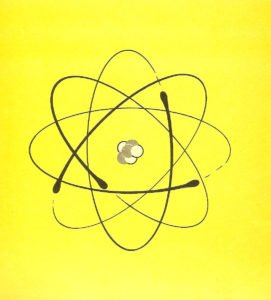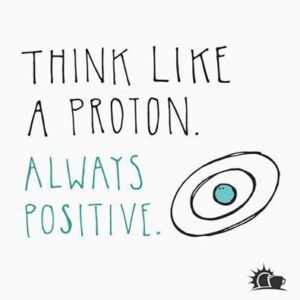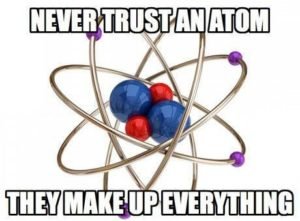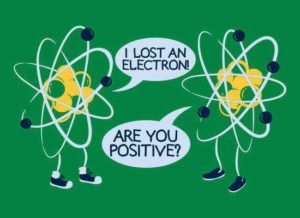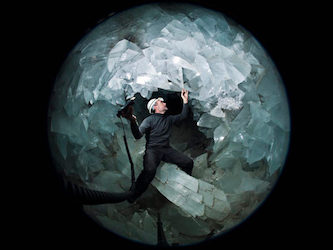
by Susan Dean | Nov 13, 2019 | Earth Science
One of
the largest geodes in the world, the Pulpí geode, was discovered in 1999. It is
deep within a mine in Spain. It is a hollow, egg-shaped object, like those in rock
shops. But it’s 36 feet wide, like a room with crystal-paneled walls. Individual
crystals are up to two meters in size, and are so transparent they look like
ice crystals. A study published
October 15, 2019, in the peer-reviewed journal Geology proposed that a slow and
steady process involving temperature fluctuations grew the giant gypsum
crystals inside. Juan Manuel García Ruiz is a professor at the Universidad de
Granada in Spain and a study coauthor. He said at Phys.org:
Unlike the giant crystals of Naica in Mexico where the hydrothermal
system is still active, the large geode of Pulpí is a fossilized environment.
The large crystals trapped a few fluid inclusions, which gave scientists
information about conditions at the time the crystals formed. The team measured
the sulfur and oxygen isotope ratios of the inclusions and found that the
gypsum likely stabilized at a temperature of about 68 degrees Fahrenheit.
Most
areas that have grown giant gypsum crystals are attached to inactive hydrothermal
systems. The fact that the crystals
stabilized at 68 F degrees suggested they may have formed closer to Earth’s
surface, where climate fluctuations may have played a role. T
Scientists suggested that the crystals had grown over a long period of
time from a slow, steady drip of a concentrated calcium sulfate solution. An
article in EOS explained: With a relatively stable temperature, many smaller
gypsum crystals dissolved to form fewer, larger ones in a process called
Ostwald ripening.

by Susan Dean | Aug 8, 2018 | Earth Science
DEVIL’S TOWER
Geologists classify it as an “igneous intrusion. Native Americans regard the tower as sacred ground. Today, the 1,267-foot formation stands as the centerpiece of Devils Tower National Monument.

NATURAL BRIDGE
Carved by a creek, Natural Bridge in Virginia’s Shenandoah Valley is one of the most famous natural sites. Standing 215 feet high, with a span of 90 feet, the formation is open to the public. Natural Bridge makes this list because its early supporters were extremely persistent in promoting Natural Bridge, once hailed as “The Eighth Wonder of the World.”

STONE MOUNTAIN
Confederate States of America icons Stonewall Jackson, Robert E. Lee and Jefferson Davis, along with their horses, are chiseled into the face of Stone Mountain, located just east of Atlanta, Georgia. Work on the carving began in 1916, but was abandoned in 1925. The sculptor who unexpectedly walked away from the Stone Mountain Carving, Gutzon Borglon, didn’t stay out of sight long — he began work on his signature achievement, Mount Rushmore, two years later. The Stone Mountain Carving was abandoned for nearly 40 years before resuming from 1963 until its completion in 1972. The carving, which is the largest bas-relief sculpture in the world, is 400 feet above the ground and measures 90 wide by 190 feet tall. In case you’re wondering, the heads of the four presidents on Mount Rushmore measure about 60 feet tall.

THE WAVE
The Wave is a rock formation located on the Arizona/Utah border. Erosion through millions of years created the swirls and ridges in the sandstone that give the area such an otherworldly appearance. Of all the rocks on this list, this is the most difficult to visit, requiring a tough 6-mile round trip hike. Access to the Wave is limited to 20 visitors per day, and applications must be made months in advance.

DELICATE ARCH
At the Arches National Park in Utah, the Delicate Arch stands out above the rest. The 52-foot-high sandstone formation is the state symbol of Utah. It is a strenuous 3-mile round-trip hike.
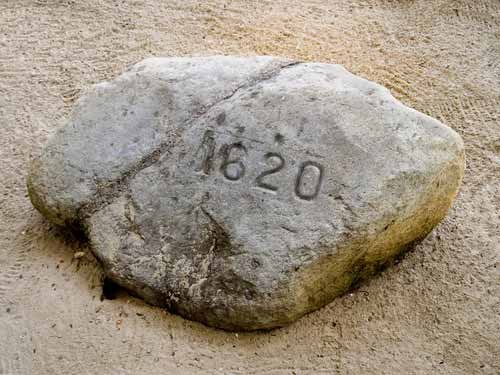
PLYMOUTH ROCK
Plymouth Rock remains an important part of American heritage. The rock is a popular attraction in Plymouth, Massachusetts.
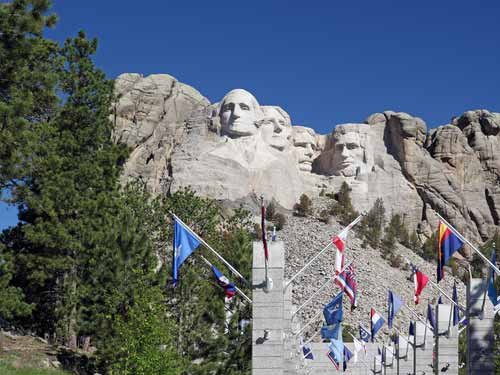
MOUNT RUSHMORE
Mount Rushmore was carved out of a granite mountainside in the Black Hills of South Dakota. The sculpture is of the faces of U.S. presidents George Washington, Thomas Jefferson, Theodore Roosevelt and Abraham Lincoln. Construction ceased in 1941 after 14 years when funding ran out.
by Susan Dean | Feb 6, 2018 | Earth Science
A little Dust Devil caught by my friend and photographer David Jones!

Jokes: How does the rain tie its shoes? In a rainbow.
What did the cloud say to the wind? You blow me away!
Weather is the variations in the atmospheric conditions experiences at a given place. It affects our lives and our activities. Climate is the usual weather over a long time: frigid, temperate, or torpid. The study of weather is called meteorology. Weather happens in the troposphere, the layer of air 8 miles next to the earth. It is caused by the interaction of the heat from the sun, air and water and the tilt of the earth as it spins around the sun. The sun is the engine that drives weather. It affects both animals and plants. As weather changes animals may migrate, hibernate, estivate, and some even change colors like the Arctic hare.
There are currents in the ocean (gulf stream) and currents in the air (trade winds). The wind comes from the earth spinning and air moving from high pressure to low pressure. Because the earth spins west to east, winds don’t blow north to south but there is the Coriolis effect where wind curves right north of the equator and left south of the equator. In the middle latitudes the winds blow mainly west. Air and water change in the atmosphere. The air can be still, moving, hot, cold, wet or dry. Air has pressure and takes up space. All air contains water vapor. Humidity is a measure of the water vapor in the air. A Front is when moist warm air meets cool dry air. Hot air moves faster than cold air and rises above cold air.
Water cycles and it can take many forms. It evaporates into the air, condenses into clouds and precipitates out as rain, snow, hail, sleet and fog. The biggest hailstone documented had a circumference of 17.5 inches(the size of your head) and weighed 1.67 pounds. A raindrop doesn’t take the shape that people depict but because of air resistance looks more like a hamburger bun. The SUN is the engine that drives the water cycle. Weather and gravity cycle the earth’s water. Water is found in fog, dew, rain, lakes, rivers, oceans, icebergs, clouds, and ground water. Water warms and cools more slowly than the soil. It evaporates, condenses, and expands when it freezes at 32 degrees and forms a six sided crystal. A molecule of water is made of 2 hydrogen atoms and 1 oxygen atom and looks like Mickey Mouse, therefore called the “Mickey Mouse Molecule” It travels in cycles and forms clouds. When moisture in the air freezes it becomes frost and covers the ground. If it freezes on plants it may form hoarfrost or it may form fernfrost on windows. Wind and water contribute to erosion and shape land (ex. glaciers).
Clouds are the biggest natural electrical generators. The basic cloud formations are stratus, cumulus, cirrus, and nimbus. A large cumulonimbus cloud can weigh more than one billion pounds!When sunlight passes through water it separates light into the colors of the rainbow. You can also do this with a prism or a glass of water. There is no energy released in a rainbow. When there is a thunderstorm, lightening travels from cloud to cloud, cloud to earth, or earth to cloud. Light travels faster than sound and we see the lightening before we hear the thunder. The lightning is electricity and because it is so hot it causes the air to expand making the thunderous sound. Lightening can have a peak temperature of 55,000 degrees Fahrenheit (hotter than the sun’s surface). There is more electricity in a bolt of lightening than can be produced by all the generators in the U.S. If you want to know how many miles away a storm is, count the time between the lightening flash and the sound of thunder and divide by 5. Light travels faster than sound. Planet earth has a negative charge and the atmosphere has a positive charge. There is a global electric current and a thunderstorm belt that surrounds the earth. Always remember “When thunder roars, go indoors!”
Droughts happen when the earth loses more water than it collects. They can happen for months or even years. Strong winds may form a vortex and act like a vacuum cleaner forming hurricanes, tornadoes, or dust bowls. It can suck up all sorts of small things from the ground or water.
A haboob is a violent dust storm that occurs only is the Sudan of Africa and Arizona. The strong winds can stir up sand and dust into a moving wall 15000 to 3000 feet high that can scrub the paint off of houses and cars.
A tornados average duration is 15 minutes however one in Missouri lasted for 7 hours 20 minutes and traveled 293 miles. It is an intense whirlwind of small diameter over land that extends downward from a convection cloud in a severe thunderstorm. They are funnel shaped, can extend 2000 feet high and may spin at a speed of 250 mph. If it occurs over water it is called a water spout. They arise from “mammatus” clouds which are thunderclouds with small rounded bumps. “Tornado Alley” stretches through the plains from Texas to Illinois.
Hurricanes are violent storms that form in warm water over the western Atlantic Ocean. They may spin 200 mph with an eye from 4 too 25 miles wide. The storm becomes a hurricane when it reaches 73 mph. Tropical storms in the China Seas are called typhoons. In the Indian Ocean and the seas north of Australia they are called cyclones.
Weird weather: Tornados and waterspouts are responsible for curious thing raining from the sky. It has rained spiders in Hungary, maggots in Mexico, thousands of tiny fish in England and the bloody rain in Europe was caused from the red sand of the Sahara desert. In London they have “pea-soupers” when the fog is thick and green from dust and smoke. When there is indoor air pollution it is called the “pigpen Effect”. When we say “It’s raining cats and dogs” we mean that it is heavy rainfall!
- Weather forecasters may include animals and plants! The pine cone closes up when there is moisture in the air. The groundhog is probably the most famous looking for his shadow. If he doesn’t see it there is supposed to be 6 more weeks of winter. Crickets chirp faster when the weather gets warmer. They say if you count how many times a cricket chirps in 15 seconds and then add 10 to the number , you get the temperature.
Natural predictors of good weather:
1. Cumulus clouds appear to dissolve and vanish
- 2. Sky is red at sunset
- 3. Wind is from the west
- 4. Clouds are high in the sk
- 5. Birds fly high in the sky
- 6. Fog rises
Bad weather predictors:
- 1. Cumulus clouds increase and move lower in the sky
- 2. Clouds travel at different speeds and in opposite directions
- 3. The sun looks hazy and has a halo
- 4. Birds fly low or not at all and are noisier
- 5. There is a ring around the moon
- 6. The sky is red at sunrise
- 7. Cows huddle and turn their tails to the storm
- 8. Crickets are in the chimney
- 9. Wooly worms have a heavier coat and there are a lot of them crawling about.
- 10. Butterflies migrate earlier
- Hornets and yellow jackets build heavier nests
California is the hottest, snowiest, and driest place in the United State. Alaska is the coldest. Hawaii is the wettest. and New Hampshire is the windiest.
Instruments used to measure weather: Weather vane(wind direction), rain gauge(rainfall), barometer( air pressure), anemometer(wind speed), hygrometer(humidity) and thermometer(heat). Today meteorologists use radar and satellites to track weather patterns.
There are 3 major concerns for our atmosphere: 1) Ozone depletion 2) Acid rain 3) Global warming
Ozone (O3) is caused by CFC’s (chloroflourocarbons) from refrigeration and air conditioning units, industrial solvents, insulation, polystyrene foam(styrofoam) and aerosol spray cans. One CFC molecule can destroy 100,000 ozone molecules. There is a growing hole in the ozone layer of the stratosphere over the Antarctic. Ozone at ground level poses serious health risks and is harmful to lung tissue. The ozone layer in our atmosphere protects us from the sun’s harmful rays.
Acid rain results from pollution of the air by power stations that burn coal or oil to generate electricity. They pour the waste gases into the air and when it rains they are dissolved in the water creating acid rain. The acid rain kills trees, plants, and life in rivers and lakes and eats away at buildings. Smoke and gases from factories and car exhaust pollute the air and form smog that can make people sick. Too much pollution can cause changes in the weather causing heat buildup, floods and droughts.
Global warming is caused by the buildup of carbon dioxide in our atmosphere. CO2 is made when we burn wood, coal, or oil. Cutting down trees or burning trees may lead to less rainfall and the buildup of CO2 in the atmosphere which raises the earth’s temperature.
Activities:
1. Make a rainbow by placing a 4″ prism in a sunny window of your room and kids can follow the path of the sun across the room. You can also make one by placing a glass of water on a piece of white paper in the sun. Make sure the paper is in the shadow. Color a rainbow.
2. Test for acid rain by chopping finely a red cabbage, pouring hot distilled water over it and let it stand for one hour. Strain the juice which should be purple. Put distilled water in one jar and the same amount of rainwater in another jar and add the same amount of cabbage juice to each jar. If the rainwater turns red it is acidic.
3. Have kids describe ice, tell where it is found and how it is used.
4. Make a wind sock (use a tall white trash bag decorated, wire, tape, and a bamboo pole), weather vane, a rain gauge, sundial or barometer. Take a large black plastic bag tied to a long string, sit it in the sun and watch the heat from the sun lift it up(best to do early morning)
5. Using a connector (from supply store listed in resources) between 2 large drink bottles to show the formation of a vortex. Young kids love this!
6. Teach the water cycle song.
7. Give children a thermometer (plastic for safety) and let them hold it in a closed hand and watch the temperature rise.
8. Make a cloud by pouring hot water in a jar, covering it with plastic wrap and putting several ice cubes on top of the plastic.(Sit jar in front of black piece of paper.) Make clouds ( stratus, cumulus, and cirrus) on a piece of paper using cotton and gluesticks.
9. Put a dry pine cone (a natural barometer) in water to see it close when it is wet and open when it dries.
10. Teach the poem
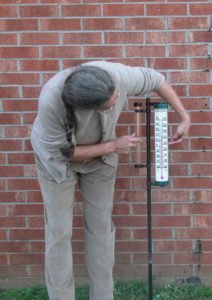
“The Thermometer”
The thermometer has a little red line,
That jumps right up when the weather is fine..
But when it’s cold as everyone knows,
Down to the little round bulb it goes.
It scrunches all up in a tight little ball,
As if it can’t stand the cold at all.
Then the weather begins to change, and
The little red line begins to climb again!A
TIME LAPSE OF A SUPER CELL
Haboob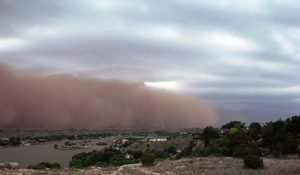
WaterSpout 
Lightening strikes a tree
STORM COMING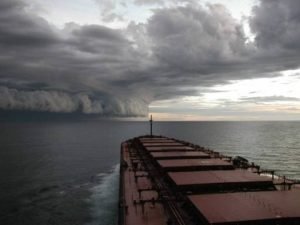

VOLCANIC LIGHTENING
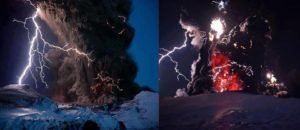
MUSHROOM CLOUD
‘Fire rainbows’ are a rare phenomenon that only occur when the Sun is higher than 58° above the horizon and its light passes through cirrus clouds made of ice crystals!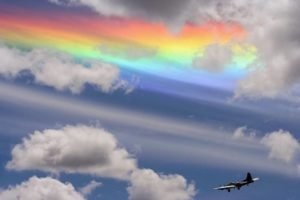

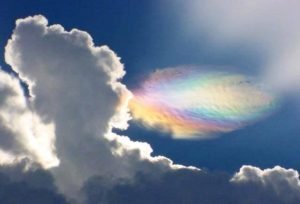
No Name Phenomenon Rainbow

Fog Tsunami Panama City, Fla.
Skypunch
Cloud Tower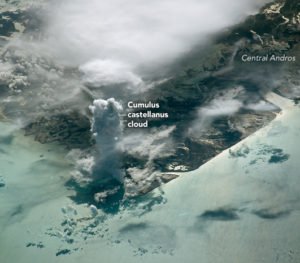
Clouds are the biggest natural electrical generators!
by Susan Dean | Feb 6, 2018 | Earth Science

Experiments with Air
Air pressure is 15 lbs. per square inch. These experiments will show that air has weight, exerts pressure, and takes up space and when air expands it makes noise. There is air in water, our bodies, and the soil and air affects many things around us. Give examples such as the rust of iron is caused by oxygen in the air. Thunder is the rapid expansion of air (and so is popping a bag or a balloon.). Air currents can be seen in smoke circulation. The air toy I use that young students like the most is a plastic arm with a little fist on the end. I open it and ask them if anything is inside. They take turns looking and all say nothing is inside. So I close it with the little fist and squeeze it and it shoots off! They learn that air takes up space and has power to move things! I wish I could find another one. Mine is almost worn out! There is also a toy that gives someone a “blast of air”! I ask kids to blow on their hand and feel the air. Though they cannot see it – it is there (invisible to them like germs). This is a good time to impress upon them that they can’t see everything – some things are so small that they are invisible!
- To show weight – tie a balloon on each end of a dowel ( pop one and watch other fall)
- Thunder = fill paper bag with air and listen to the sound from the rapid expansion of air
- Showing currents = a smoking rope in a jar. Ask why circulation occurs.
- 2 wet cloths on chalkboard. Fan one of them. Air hastens evaporation. Dry hot air hastens it even more.
- If you cut off the air from a flame it goes out (no oxygen.)
- Put a string through a straw and attach the string to opposite walls and attach a filled rocket balloon (that you can let the air out of) with tape to the straw to show jet thrust.
- Put a paper in a jar and lower it in water. The compressed air keeps it dry.
- Put water in jar with a piece of cardboard over it. Turn it upside down and see air pressure at work.
- Try to separate 2 rubber cups to feel air pressure
- Put some water on the back of your hand and blow. How does it feel? Evaporation takes heat with it.
- Use 2 jars of water and a tube to siphon and create an air vacuum
- Two objects of different weight fall at = speed and shape changes air resistance. (Galileo). Try a crumpled paper and a flat paper.
- Air moves things. Try straws and ping pong balls.
Jump on air!
- Name some ways we use air. Ex. tires, bubble wrap, mattresses, cooling,
- Make little flags to check out currents in the classroom
- Straw and water make a dropper,
- Name some sounds air makes. Bubble wrap makes a sound when popped. And sound is made when air moves through trees, the roar of a hurricane.
- Ice in a can with salt forms dew on outside.
- Pour air from one glass to another under water
- Put a balloon in the fridge. It expands when taken out.
- Get a solar balloon and let kids see how the warmed air in the balloon (from the heat of the sun) makes the balloon rise.
Airborne Pollutants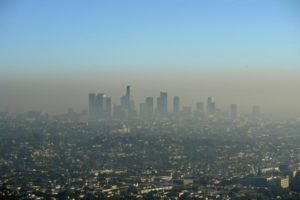
EXPERIMENT TO TEST FOR AIRBORNE POLLUTANTS
Air is invisible. It is made up of gases that cannot be seen. Many major air pollutants are invisible gases. In some areas of the country, these air pollutants can build to levels where they can be seen. For example, in some cities, smoky, yellowish clouds of primarily car exhaust build up to create smog.
Other easily visible air pollutants, called particulate matter, are made up of tiny particles of solids or droplets of liquids. Some of these particulates are naturally occurring and may pose less of a problem to human health than man-made particulates. Some natural particulates include pollen, wind-blown dust and volcanic ash. Man- made particulates are generated by coal and oil- fired power plants and manufacturing plants, automobile and diesel fuels as well as fireplaces and wood-burning stoves among others.
Place collectors where they can hang freely – not touching other surfaces and where they will not be touched by other students. Be sure to let the custodial staff know about your experiment, too. These particles carried through the air can be harmful to plants, animals and humans. Buildings and statues can be discolored and corroded
Let students make stick-up collectors to see the air pollution. Cut holes in strips of poster paper and cover the holes on one side with clear tape. Put name, date, and location on each strip and select places around the school to hang them. They should hang freely and not be touched. Tell custodial staff about the experiment.
After a week, retrieve the Stick Up collectors and analyze. Can students see pollution with the naked eye. Inspect the strips with a magnifying glass or microscope.
by Susan Dean | Feb 6, 2018 | Earth Science

MAGNETISM
Magnetism is one of the strangest things in nature! What happens is a dance of electrons!
It’s believed a shepherd discovered the first magnet when a rock stuck to a nail in his sandals! A wall of magnetic stones pulled a W. Va. miners helmet off his head! Magnetite or lodestones are natural magnetic rocks found in iron deposits and they get there because a bacteria that breathes without oxygen, enjoys the dark and likes to eat iron. When they digest iron it is turned to magnetite. Many animals have cells that contain magnetite. Scientist think magnetic cells help animals (bees, tuna, dolphin and whales) find food and migrate. In certain parts of their brain we find magnetite. It may help them tell up from down. Whales have been stranded in areas of irregular magnetic fields. Humans have a small amount of magnetite lining their noses. Scientists think our noses were once like compasses!
Magnets attract certain objects and produce magnetic fields which come together at the poles. Opposite poles attract. The magnetic force is strongest at the poles and weakest at the center. The magnetic field is the lines of force around an object. Like poles repel / unlike poles attract.
Pure metals have the same kind of electrons. Atoms are the basic substances of the universe and the nucleus and electrons have opposite charges. Different substances have a different # of electrons circling around the nucleus. Electrons form a sort of cloud around the nucleus. Atomic particles may spin, charge in motion, and have a magnetic moment. The spinning motion makes the larger atom magnetic. Electrons may spin in the same or opposite directions. If 2 spin the same it is a strong magnet. If 2 spin in opposite directions they cancel each other and have a magnetic moment of 0. Atoms of certain elements line up in domains and have a magnetic field.
Ferromagnetic – magnets such as iron, nickel, cobalt lodestone (the magnetic atoms of the same substance turn toward and away from a magnet because of a peculiar crystalline structure.) Ground up magnetite is mixed with plastics to make refrigerator magnets. Powdered ferrites coat magnetic recording tapes.
Paramagnetic means having a slight magnetism such as gold, copper, aluminum and can be detected with a magnetometer. If you make an aluminum pan cold enough it will behave like an iron magnet.
Diamagnetic includes silver and most others and is the natural magnetic quality of all matter – even human tissue. Human tissue responds to a strong magnetic field. Stand next to a strong magnet, the atoms in your body repel the magnet!
Temperature and magnets – If the temperature of ferromagnetic metal is raised, the magnetism disappears. The point that it loses its magnetism is called the Curie temp. If you lower the temp of rare earth metals, they become magnetic. Atoms of materials shift around in different ways. Magnetite (3 iron, 4 oxygen) is found in any good rocky area and resembles grey lumps of coal heavy for their size. Use a compass to find them.
Blood hemoglobin contains iron that gives blood its red color. Hematite (rust) is a more common compound of iron. Lodestone has large crystals of magnetite and a permanent magnetism. A Chinese compass uses lodestone floated in water on a small boat. The density of magnetite is over 5. 1 cup of magnetite weighs 5 times that of a cup of water. Pure iron has a density of 8.
If you freely suspend a bar magnet it lines up like a compass and always has a north and south pole. Magnetic particles line up in the same direction. Dropping or heating a magnet will damage it and cause the particles to shift positions. Magnetic transparency is the ability of a magnet to attract through non-magnetic materials. Most materials are non-magnetic. Metals attracted to a magnet are called FERROMAGNETIC like iron. Iron has the strongest attraction to a magnet. Copper, aluminum and gold have weak attractions. Magnets can be created. In 1820 Oersted discovered that electricity produces magnetism. Wherever electricity goes, magnetism follows = electromagnetism. A dry cell battery coil of wire around nail makes a temporary electromagnet. Electromagnetic waves travel through anything, even through a vacuum. Magnets are used on cranes, latches, stud finders, doors, tapes, VCRS, TVS, bells, buzzers, machines ,vacuums, speedometers, computers, credit cards, automatic tellers and in physical therapy.
MATERIALS: Magnetic wands, small amt. of Total cereal, paper clips, 3 nails, materials for magnetic sculpture, 2 bar magnets, round magnet, horseshoe magnet, compass, balloon, salt, pepper shaker of iron filings, 3 feet of insulated copper wire, 6 volt battery, liquid crystals, rust mixed with sand.
ACTIVITIES:
- Have a ferromagnetic scavenger hunt!
- Test magnets through different materials.
- Do magnets work through water?
- Create a magnet sculpture.
- See how many paper clips you can hang from each other.
- Cereal contains iron (Total works best) and you can pick up particles with a magnet.
- A magnet erases tape recordings.
- The needle of a compass is a magnet.
- A compass on the North Pole will spin in circles.
- The forces of attraction and repulsion may be strong or weak.
- Any moving magnetic field will produce an electrical current.
- Rub a balloon on hair 12 times and you can pick up salt.
- Horseshoe magnets work well lifting heavy objects. Because the poles are close together, they combine strengths.
- Magnetic field examples: Put filings in a pepper shaker and test fields by putting beneath paper a bar magnet, a round magnet and a horseshoe magnet.
Bipolarity is one of the most puzzling differences between magnetism and electricity. Magnetic fields have 2 poles that cannot exist apart. If you break a magnet apart, a North and South Pole appear at the ends of the 2 pieces (like the brooms in the sorcerer’s apprentice!) The magnetic field always wraps around itself, flows into itself, and can never separate from its poles. Electricity can only travel in one direction. There is an odd relationship between electricity and magnetism. A magnetic field produces electricity. An electric current creates a magnetic field. Magnetism passes through many materials that do not conduct electricity ex. glass, plastic. When electricity passes through a wire it creates a magnetic field around the wire and you can reverse the current and reverse the poles.
An MRI is magnetic resonance imaging. The machine is like a big donut and takes a picture by reading the turning of atoms in tissue.
Dating with magnets = Thermo remnant magnetic dating notes the direction of the poles of magnets found in the ground.
Bombs in WWII: Nazis dropped mines on bottom of rivers with inclinometers and when a ship passed over, it triggered them. The ships had to be demagnetized.
Liquid crystals change when exposed to magnetic fields and can shut out light like closing a shutter. They are large irregular molecules such as nitrobenzene
Plasma magnetism in the future? = magnetized water. Lightening changes water so more nitrogen sticks to it. To gather micrometeorites in water the best time is Aug. 11 – Dec. 13
Earth is the biggest magnet. We think it is from the huge electric currents deep within where molten iron surrounds a solid core of iron. The motion creates electricity. The earth’s magnetic field can change. It is believed the poles reversed at one time. In ancient clay banks magnetite needles are frozen in time and N points south. If you are close to one of the poles the needle stands on end. An inclinometer measures the angle of dip to figure out distance from pole. A magnet can cause damage to computers and tapes.
Insulators are shields to protect against magnetism.
Experiments:
1. Make a nail into a magnet: Dissolve the domains and make them line up in the same direction. You will need 3 nails of iron. Stroke a nail with a bar magnet 20 times and touch the staples to test. Pound a nail with hammer holding with end pointed north. It will break apart the domains and force atoms to line up. Wrap 3 foot insulated copper wire around a nail and connect the ends to a 6 volt battery – electric current flows in one direction ( electromagnet) is used on cranes to pick up scrap metal. You can switch it on and off. If you remove copper wire staples drop and it loses magnetism
2. Experiment: Observe the Poles. Use 2 bar magnets and dip N pole of one in filings. Dip S pole of other in filings. Notice how filings hang on when put together or pull apart. Dip both N poles in filings. Put together and pull apart. Filings will repel each other
3. You need a ruler, bar magnet and staples. Slide magnet toward staples and measure when pulled. Try through plastic, cloth, tissue, foil, rubber, glass slide. None work well as insulators, a strong magnetic field goes through everything
4. Attach ball bearings to end of bar magnet. 3rd ones push apart. Add the 4th and join. Both attract and create 2 north poles in 7th bearings
5. Mix rust and sand put in saucer and push around to pick up with magnet.
6. There are 2 kinds of compass = radial and dip. Magnetic suspension cushions objects. Mr.Farraday discovered the magnetic dynamo with a copper wire wrapped into circle and tied with 4 twist ties. Wrap free ends of wires around compass in same direction connecting the wires. Move bar magnet in and out of center and the compass needle jumps. The movement produces an alternating current.
7. Heard of levitating ladies with bar magnets! Magnetism is stronger than the force of gravity. Make a magnetic wand for tricks.
Game: Go fish with magnets. Punch holes in fish for points. If catch tire then put fish back or lose turn
Get magnetic wands here: Magnetic Wands
by Susan Dean | Feb 6, 2018 | Earth Science
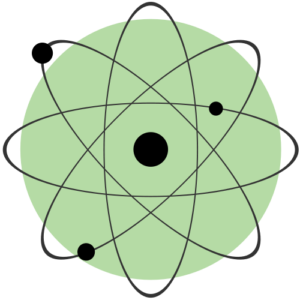
Elements are Everything – Atoms, Structure and Form (Liquid, Gas, or Solid) Elements around us, in the Air and water, and in our bodies and everywhere!
Elements are the building blocks of all matter.
MATTER HAS THE MAIN PROPERTIES OF: COLOR, SHAPE, SMELL, TEXTURE, WEIGHT, MALLEABILITY, SURFACE TENSION, SOUND, TEMPERATURE, MAGNETISM, ELASTICITY, COHESION
Everything is made up of atoms of elements and temperature changes their behavior. They tighten together and jiggle when they get cold and when they are hot they move apart quickly and jump around even jumping into the air!
They can have a positive or negative electrical charge and have a center body(nucleus) that is kind of like a little bag of marbles that has different numbers of tiny bodies (electrons) spinning around it. Some are light weights and some are heavy weights! Balloons are filled with helium. It is lighter than anything in our air close to the earth and floats up into the sky.
Children might be familiar with a few elements: oxygen, calcium, sulfur, potassium, magnesium, sodium, hydrogen, iron, nickel, copper, silver, gold, mercury, carbon, aluminum, chlorine, arsenic, tin, lead, iodine, krypton, neon. Show them some samples. Ask children if they can name some of the elements.
Elements are made of atoms that are all alike, one kind of atom, ex. oxygen. When oxygen joins to another kind of atom Hydrogen, it becomes a molecule – 2 different atoms join together to make water – H2O – the Mickey Mouse molecule made of 2 hydrogen’s and 1 oxygen. Point out some of the elements on the chart as they name a few. All of the body needs oxygen to be alive. Our lungs take in air and our red blood cells grab it from the air and carry it off to feed the cells of our body. There are more than 100 elements.
Our body is made mostly of 5 elements: Oxygen 65%, Carbon 17.5%, Hydrogen 10.2%, Nitrogen 2.4%, Calcium 1.6%, others 3.3
The Earth is made mostly of 5 elements: Oxygen 49.5%, Silicon 25.8%, Aluminum 7.5%, Iron 4.7%, Calcium 3.4%, and Others 9.1
The Air close to the earth is mostly 3 elements: Nitrogen 78%, Oxygen 21%, Carbon Dioxide 1%
Materials: Chart of Elements, Molecule of water (the “Mickey Mouse Molecule” is easy to make of paper mache). Samples of elements: silver, gold, tin, iron, copper, helium in balloon, charcoal (carbon), sulfur. Earth, body, and air charts of the elements (pie charts are easy for children to visualize.)Colored marshmallows and toothpicks to make a molecule of water.
Activities: Children act out behavior of atoms. Stand close together and just jiggle (frozen). As molecules heat up they get more active. As they get cold they freeze in place and jiggle. When they melt to liquid they move sliding around. When they heat up they move fast even jumping into the air. Construct a molecule of water using the colored marshmallows. Draw simple pictures of the hydrogen atom. Draw a small ball and fill it in and then draw a tiny ball out from it and a circle going through it showing that the electron circles the larger body in the center (nucleus). This is a simple picture and simple science.

